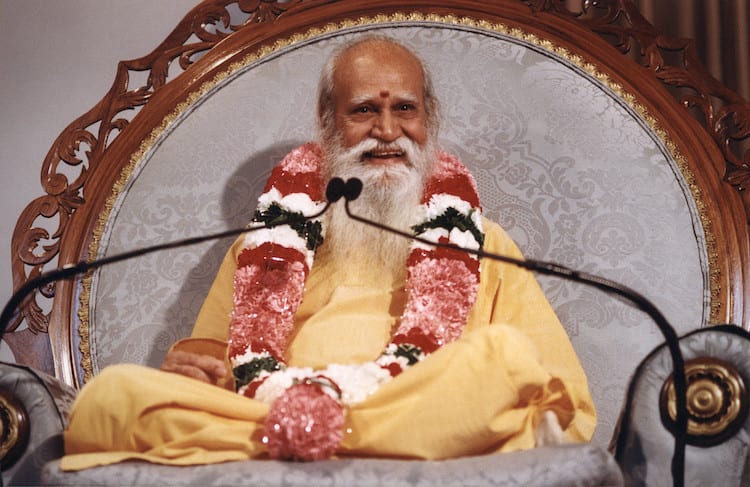Let us talk a little about samadhi. ln lndia, normally if you say, “He has attained samadhi,” that means he has died and is buried. That is the normal connotation for that term. ln a way, samadhi is like that. You are dead, yet you are alive. My Master Sri Swami Sivanandaji used to sing this song: “When shall l see Thee? When ’l’ ceases to be.” He was asking this question of the Lord. “Lord, when can l see You? l know that will be when ’l’ ceases to be.” That means that if the ego or “l” dies, you can truly live.
If the little egoistic “l” goes away from you, you are free from the ego. You are clean, pure. At that stage you are fit to go to heaven, to experience the highest knowledge or the highest truth. That is what we call samadhi. This is the essence of all spiritual teachings and practices — it doesn’t matter what label they have. One can be a Catholic, a Protestant, a Jew, a Hindu, Buddhist, Muslim, or any religion. Even if you don’t have any faith at all or don’t believe in any organized religion, it doesn’t matter. That is not the criteria to have this realization. All you have to accomplish is to see that all selfishness goes away.
Where does the “l” dwell? ln ego. Where does the ego live? ln the mind. The ego is, in a way, the very source of mind. All developments are part of ego. So the sum total of all these things — thinking, feeling, willing – could be put together under one term, “mind.” lf the mind gets completely purified, then it’s no longer an obstruction to your experience of the Truth. When it is clean and clear, the mind doesn’t color the appearance of the pure Self. lt becomes a pure reflector forthe Self to see its own true nature. That is the essence of Yoga. According to Sri Patanjali, what is the definition for Yoga? Control of thought waves. Yogas chitta vritti nirodhah. Chittam is the sum total of mind. Vritti is the wave. Nirodhah is the absence. So when the chittam is freed of the waves or disturbance or turbulence, it becomes crystal clear. That is the samadhi state.
Waveless Ocean
The spirit doesn’t have to attain samadhi. The spirit is the God in you. The Bible calls it the image of God. Can God ever get disturbed, colored, disappointed? No. The real you, as the image of God, is always pure. The Bhagavad Gita says, “I am unborn, undying; l am eternal, never-changing. l am always the same.” The Self doesn’t need samadhi. It is already in that state. It is always the same.
What looks for samadhi? The mind or the chittam. Samadhi means that the mind comes to a tranquil state, like waveless water. A Tamil saint gives this example of samadhi; “When l attain, experience the samadhi, my mind will be like a waveless ocean…like a lamp without any soot covering it, always eternally brilliant light.” Another example he gives says, “My mind should be like the pointer of a scale that doesn’t get influenced either by a lump of gold or a lump of clay.” The scale simply gives you the weight. lt doesn’t get excited if a lump of gold is put there. It doesn’t want to lean more toward that. lt is not influenced by the material, it weighs all the same. That is what we want in a balanced mind.
When would you want to prove yourself to have attained that balanced state? During adversities. When everything goes smoothly, then you are easily balanced. “Ahh, wonderful. l am so peaceful.” Fine, but what if somebody comes and says, “Hey, you rogue! What are you doing here?” Your mind should still say, “Ahh, how peaceful l am.”
Situations will arise to test you. You may think that you are in a peaceful state and have attained complete tranquility. All of a sudden somebody will insult you. You should still be able to smile at him and say, “Oh yes. That’s the way you see me. That’s fine. You are free to think any way you want.” One person might see you as a rogue. Fine. The other fellow might see you as a guru. Fine. lf you know who you are, if you have attained the stage of tranquility, nothing should affect or sway you. Once in a village there lived a wise man. He was very peaceful; nobody had ever seen him disturbed. All the villagers said, “Oh, he is such a peaceful person. lt’s hard to find someone like that.”
One fellow became a little jealous and said, “Ha! What kind of peaceful man? You just wait and see. l’ll make him angry.” So he went to where the wise man was sitting and said, “Hey! Swami! What kind of man are you? lt looks to me like you’re cheating people, presenting yourself as a big guru, getting Guru Poornima and birthday gifts!”
The wise man didn’t react; he simply smiled. So the challenger started calling him all kinds of foul names. Still the wise man smiled and said nothing. Finally the man yelled, “Hey, Swami! l’m talking to you! l’m saying all this about you. Don’t you want to say something?”
The wise man spoke calmly; “My dear friend, suppose l give you an apple and you say, ‘l’m not ready to accept it.’ What should l do? Should l throw it out? l’ll take it back, is it not so? You want to give something and the person is not interested in accepting it. You won’t dispose of it. You will take it back, put it in your pocket and go home. In the same way, you are trying to give me something, but l am not interested in accepting it, so take it back. lt’s yours!”
Testing
The equanimity should be tested now and then. lt’s easy to say, “l’m totally peaceful,” but being that way is another story. Once a swami went into a cave and stayed there for almost ten years. He didn’t see anybody. People used to come and leave some food for him; and then when they left, he would come and take it. After ten years, one day he decided to come out and meet the people. Everybody came running. “The swami is out of the cave now! He is seeing everybody, giving darshan to everybody.” Thousands came to see him. “Swami, Swami, by sitting in the cave these ten years what did you gain?”
He replied, “Years ago l used to be very angry. Even a little thing would disturb me. But for the past ten years, no anger at all. l conquered anger. That is a big achievement.”
Someone got up and said, “Swami, how can you remember all that happened for the past ten years? Maybe one day you might have forgotten and become a little angry.” “No, not at all. Not even once did I get angry.” Another fellow stood up. “Sir, it is hard to believe. Are you sure that there wasn’t one time when you were angry?” The swami sounded a little impatient. “Absolutely not.” Still another person asked, “Really? Didn’t you even feel slightly angry?” The swami’s voice roared with anger, “Never! Never! Do you hear me? l totally conquered anger!”
Yes, when there is nobody to irritate you, you are totally peaceful. When there are no pretty girls or boys around, everybody is celibate. When there is no food, you say “I’m fasting.” That won’t prove that you have conquered the situation. You should have ample opportunities to be disturbed. lf such opportunities come and you still remain peaceful, then only you have proved that you have achieved something. Of course sometimes we need a protective, supportive environment in which to grow strong. But we should never think that we are hiding from the world.
Make Mistakes
Religion is studied and experienced to learn to be free. lf you cannot have freedom in religion, you are not going to have freedom in anything else. Religion is used to free you from bondage. The aim is to be fully liberated. To help you attain that freedom, a guru or spiritual teacher will not bind you. He or she can give you some guidelines and some disciplinary practices, but it should not be a bondage.
lf you make mistakes, it doesn’t matter. Make mistakes and learn. The best teachers are your own mistakes. You learn even faster by your mistakes. Once l was at a conference with the modern great scientist, Buckminster Fuller. He was the Leonardo da Vinci of this age. He stood up and said, “Friends, forget about all the ‘Do this. Don’t do that’ business. Commit as many mistakes as possible, as soon as possible. You’ll become great!”
lt’s true. Every failure is a stepping stone. Remember though that you can’t have the same stone for each step. Every time it should be a new stone. That means, don’t keep making the same mistake. Learn well from each one. That is the trouble with many people, they commit the same mistake over and over. Even then, they will eventually learn from that mistake and move on. Experience is the best teacher, and one should learn in his or her own way. That is the reason why we even call this “lntegral Yoga.” Sometimes l hear people limiting it; “lf you don’t do such and such, you are not an Integral Yogi.” “lf you don’t do Hatha Yoga, you are not an lntegral Yogi.” “lf you don’t learn Patanjali’s Yoga Sutras, you’re not an lntegral Yogi.” “lf you don’t practice a certain amount of pranayama, you’re not an lntegral Yogi.” Whatever you do, you are an lntegral Yogi. That’s our approach. As long as you want to be a yogi, that’s enough for me. You choose whatever way you like. All the paths lead to Rome. Even if you take a wrong direction, it doesn’t matter. Take it. You will learn something. Don’t just stand in the middle doing nothing. That’s what is terrible. A good teacher should say, “This is the way l know. lt is positively helpful. If you like, follow it.”
Suppose you say, “l don’t want to go that way. I want to go in the opposite direction.” The teacher will say, “All right. Go ahead. Do it.” Then you go in the wrong direction, bump against a wall, and say, “Ahh. l made a mistake. lt’s the wrong direction. l’ll go the other way.” That’s what experience means. Nature itself teaches us, allows us to make mistakes.
(By Swami Satchidananda, from the IYTA Newsletter, November 2011)



